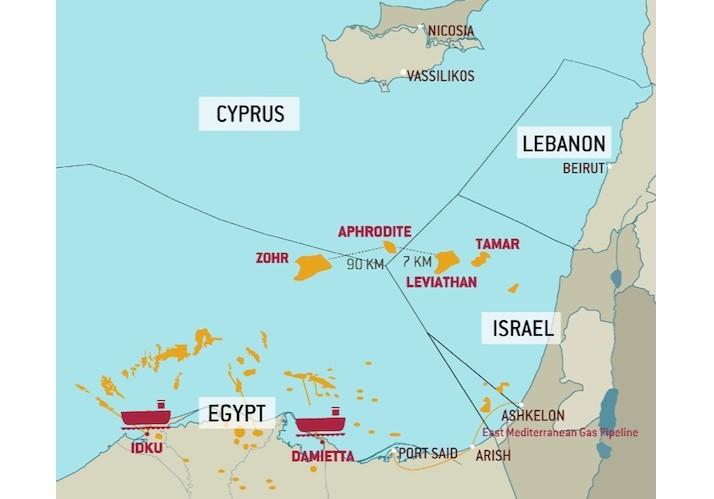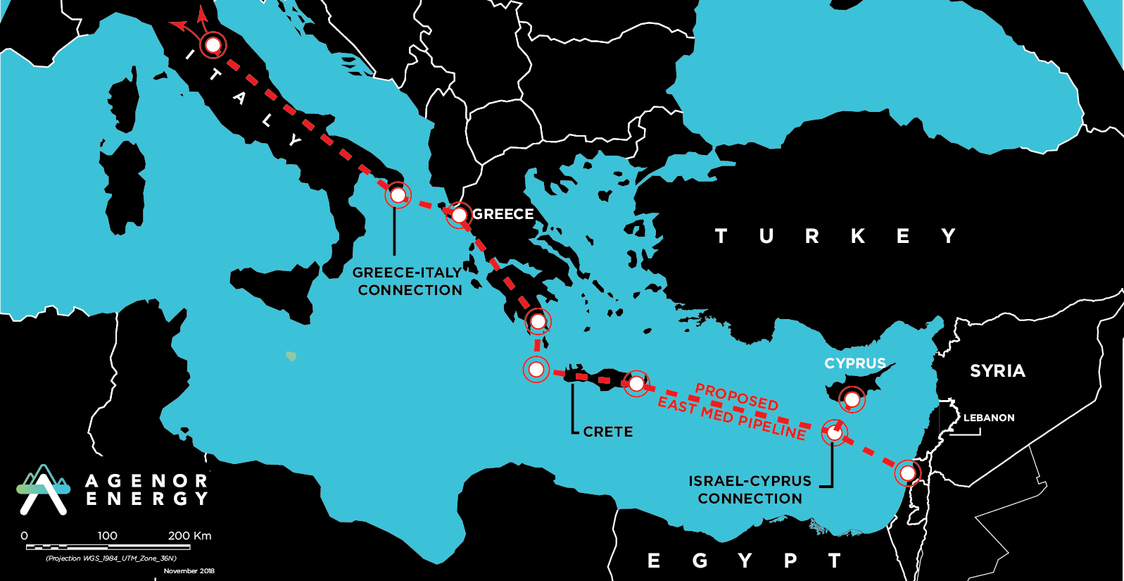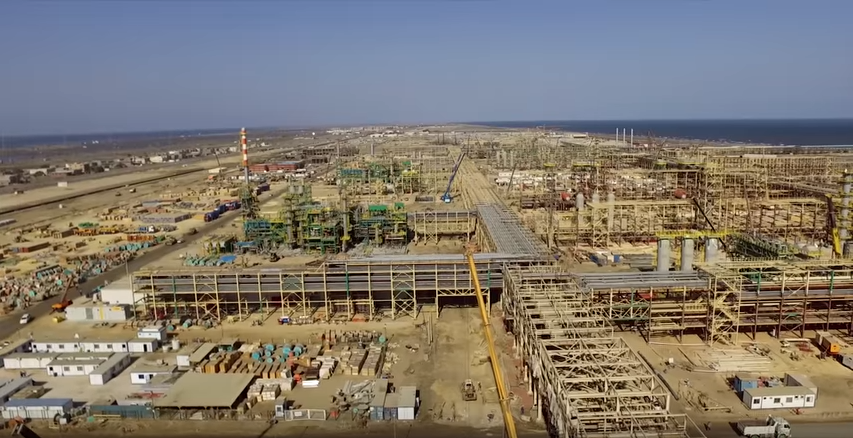The new energy geopolitics of “East Med”
The Eastern Mediterranean has become a major hotspot for the natural gas industry and geopolitical competition driven by several offshore discoveries in the last decade. These discoveries have attracted increasing interest among several international oil companies and countries. Due to energy ambitions, boundary disputes and regional competition, the Eastern Mediterranean has also become the stage of high tensions and confrontation by different countries, particularly between Turkey and Greece. Indeed, the development of energy resources and potential export routes has shaped and, in turn, has been shaped by, wider regional dynamics.
All this started with Noble Energy (headquartered in Texas) announcing the discovery of the Tamar field off Israel’s coast in 2009, with an estimated capacity of 280 billion cubic meters (bcm). Within two years, Noble Energy announced two additional discoveries: the Leviathan field (620 bcm), also off Israel’s shore, in 2010 and the Aphrodite field (140 bcm), within Cyprus’ waters, in 2011.

This reinforced the regional ambitions to make the Eastern Mediterranean (or EastMed) a gas-exporting region. These ambitions were based also on two assessments done by the US Geological Survey (USGS) in 2010, which estimated the presence of nearly 9,800 bcm of undiscovered technically recoverable gas and more than 3.4 billion barrels of oil resources in the region. However, the real game-changer (for regional energy ambitions) occurred in 2015 when the Italian Eni announced the discovery of the giant Zohr gas field off Egypt’s coast. With its 850 bcm of estimated gross mean resources, the Egyptian offshore field is the largest ever discovered in the Mediterranean Sea.
Due to EastMed’s high prospects, several actors – both regional and external – have shown interest in the energy resources and potential export routes. A wide range of export options have been discussed, taking into consideration both pipelines – the EastMed pipeline through Cyprus and Greece and another from Israel to Turkey – and the LNG infrastructure (in Egypt, Cyprus or Israel), in order to transform the region into a gas-exporting hub.
Israel was the first to experience the discovery of natural gas in its waters; however, it has faced several regulatory issues, which cooled down its ambitions. It managed to quickly develop the Tamar field, which became operational in 2013, supplying Israel with 7.5 bcm/year of gas already in 2014. Israel saw natural gas as a useful tool for enhancing cooperation with its Arab neighboring countries. For example, as part of a historical agreement to deliver 85 bcm from the Leviathan and Tamar fields over 15 years for a total estimated value of $19 billion, Israel commenced to export its gas to Egypt in January 2020. Currently, this gas is feeding Egypt’s domestic market, but it could be exported via Egypt’s LNG terminals in the years to come.

Moreover, another important development is the access of the first major US oil company, Chevron, into the Israeli gas sector, which was historically avoided in order to appease Arab oil-rich countries. In July 2020, Chevron announced its acquisition of Noble Energy’s assets in the Eastern Mediterranean for $5billion, despite the negative effects on the energy companies and prices due to the COVID-19 pandemic.
The small island of Cyprus welcomed the discovery of Aphrodite, despite its small capacity. In 2018, Eni announced the discovery of Calypso, with an estimated capacity of 200 bcm and in 2019 ExxonMobil and Qatar Petroleum announced the discovery of the Glaucus-1 field with an estimated capacity between 142 and 227 bcm. Natural gas could help Cyprus reduce its dependency on dirtier energy sources, given oil’s great share in the country’s energy mix; however, current resource volumes do not make it plausible for Cyprus to become a significant gas player in the foreseeable future.
Moreover, the development of Cyprus’ gas resources and potential export routes through the small island are hindered by the (geo)political opposition of Turkey. Given the ongoing political dispute between Nicosia and the Turkish Republic of Northern Cyprus, Turkey considers all exploration activities off the shore of Cyprus to be illegal and tries to prevent them through its own version of “gun-boat diplomacy”. Moreover, Turkey’s opposition has targeted the development of potential export projects, especially the EastMed pipeline. The pipeline could deliver 10 bcm annually of gas from the Leviathan Basin directly to Europe through Cyprus and Greece. Turkey has been promoting itself as a gas corridor between Asia and Europe; thus, this pipeline would undermine this goal and narrative.

Ankara also signed a maritime border agreement with Libya’s Tripoli-based government in order to prevent the development of the pipeline, showing that energy issues are deeply intertwined with the broader competition in the region. However, despite these obstacles, the forecast of the decrease in Europe’s gas demand in the long run due to decarbonization policies and the current low gas prices make the project seemingly unfeasible; the entire project is estimated to cost more than $6 billion.
With the discovery of the giant Zohr field, Egypt became a major energy player in the area. Thanks to the incredible fast-track development of the field, Egypt managed to return to an energy self-sufficient status, after several years of dependence on gas imports. The Zohr gas fields also marked the entry of Russia into the EastMed gas saga: In 2016, Rosneft bought a 30% participating interest in the Shourouk Concession off Egypt’s shore, where the Zohr field is located. In doing so, Russia ensured a share in the development of the gas in the region, which is seen as an alternative source of supply for European markets. Inevitably, the great reserve capacity of Zohr ignited further exploration activities offs Egypt’s shore, as well as in the Nile Delta. Egypt could use its two LNG terminals – in Idku and Damietta – to put in place a competitive gas export infrastructure with a combined capacity of 19 bcm annually. This would be the least expensive option and could provide more flexibility compared to the EastMed pipeline, which would be linked exclusively to Europe.

In favor of this option, Egypt, Cyprus and Israel could benefit from the geographical proximity of gas fields in the area: Zohr is located only 90km away from Aphrodite, which in turn is only 7km away from Leviathan. This could allow a coordinated development of the fields and the creation of the economies of scale needed to put in place a competitive regional gas export infrastructure. On January 14, 2019, these countries established a diplomatic framework with other countries (Jordan, Palestinian National Authority, Greece and Italy) called the East Mediterranean Gas Forum (EMGF) in order to improve energy policy coordination in the region; an initiative seen in opposition with Turkey’s regional and energy policy.
Nevertheless, the EMGF also shows how countries in the region are struggling to find a viable solution for the natural gas discovered in the area. Indeed, Israel, Cyprus and Greece signed an inter-governmental agreement in January 2020 expressing their commitment to the EastMed pipeline, which would inevitably exclude Egypt.
In short, each country has seen these discoveries and resources as a useful tool to pursue political, energy and economic goals both domestically and regionally. Energy issues are deeply interlinked with the broader regional context and competition, and for these very reasons, regional players must combine economic interests with geopolitical considerations. Nevertheless, major pipeline projects seem unlikely to become a reality due to economic difficulties and (geo)political obstacles. Given the current volumes discovered, it seems to be more feasible to use existing infrastructure, as it would also foster regional cooperation among at least some of the countries in the region.
